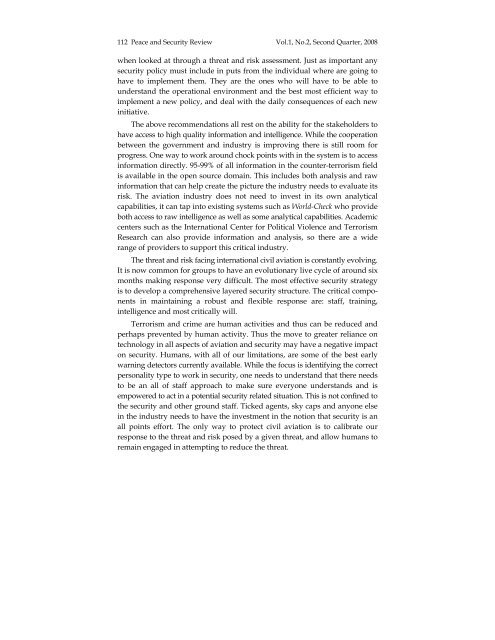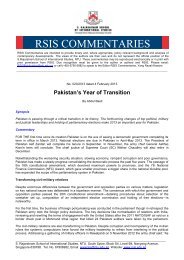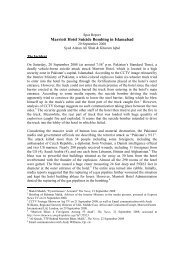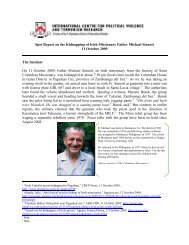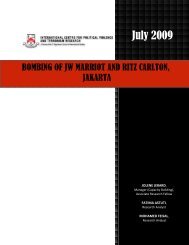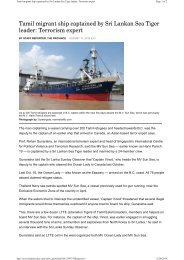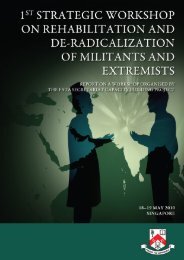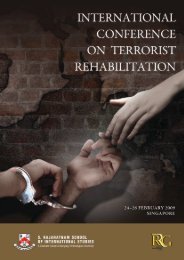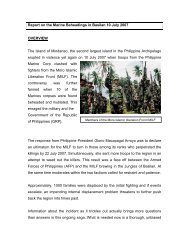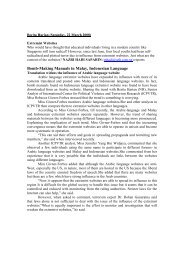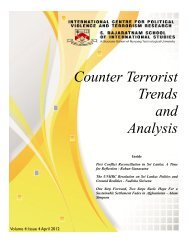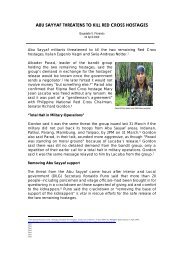Peace and Security Review, Vol.1 No. 2 - International Centre for ...
Peace and Security Review, Vol.1 No. 2 - International Centre for ...
Peace and Security Review, Vol.1 No. 2 - International Centre for ...
Create successful ePaper yourself
Turn your PDF publications into a flip-book with our unique Google optimized e-Paper software.
112 <strong>Peace</strong> <strong>and</strong> <strong>Security</strong> <strong>Review</strong> <strong>Vol.1</strong>, <strong>No</strong>.2, Second Quarter, 2008<br />
when looked at through a threat <strong>and</strong> risk assessment. Just as important any<br />
security policy must include in puts from the individual where are going to<br />
have to implement them. They are the ones who will have to be able to<br />
underst<strong>and</strong> the operational environment <strong>and</strong> the best most efficient way to<br />
implement a new policy, <strong>and</strong> deal with the daily consequences of each new<br />
initiative.<br />
The above recommendations all rest on the ability <strong>for</strong> the stakeholders to<br />
have access to high quality in<strong>for</strong>mation <strong>and</strong> intelligence. While the cooperation<br />
between the government <strong>and</strong> industry is improving there is still room <strong>for</strong><br />
progress. One way to work around chock points with in the system is to access<br />
in<strong>for</strong>mation directly. 95-99% of all in<strong>for</strong>mation in the counter-terrorism field<br />
is available in the open source domain. This includes both analysis <strong>and</strong> raw<br />
in<strong>for</strong>mation that can help create the picture the industry needs to evaluate its<br />
risk. The aviation industry does not need to invest in its own analytical<br />
capabilities, it can tap into existing systems such as World-Check who provide<br />
both access to raw intelligence as well as some analytical capabilities. Academic<br />
centers such as the <strong>International</strong> Center <strong>for</strong> Political Violence <strong>and</strong> Terrorism<br />
Research can also provide in<strong>for</strong>mation <strong>and</strong> analysis, so there are a wide<br />
range of providers to support this critical industry.<br />
The threat <strong>and</strong> risk facing international civil aviation is constantly evolving.<br />
It is now common <strong>for</strong> groups to have an evolutionary live cycle of around six<br />
months making response very difficult. The most effective security strategy<br />
is to develop a comprehensive layered security structure. The critical components<br />
in maintaining a robust <strong>and</strong> flexible response are: staff, training,<br />
intelligence <strong>and</strong> most critically will.<br />
Terrorism <strong>and</strong> crime are human activities <strong>and</strong> thus can be reduced <strong>and</strong><br />
perhaps prevented by human activity. Thus the move to greater reliance on<br />
technology in all aspects of aviation <strong>and</strong> security may have a negative impact<br />
on security. Humans, with all of our limitations, are some of the best early<br />
warning detectors currently available. While the focus is identifying the correct<br />
personality type to work in security, one needs to underst<strong>and</strong> that there needs<br />
to be an all of staff approach to make sure everyone underst<strong>and</strong>s <strong>and</strong> is<br />
empowered to act in a potential security related situation. This is not confined to<br />
the security <strong>and</strong> other ground staff. Ticked agents, sky caps <strong>and</strong> anyone else<br />
in the industry needs to have the investment in the notion that security is an<br />
all points ef<strong>for</strong>t. The only way to protect civil aviation is to calibrate our<br />
response to the threat <strong>and</strong> risk posed by a given threat, <strong>and</strong> allow humans to<br />
remain engaged in attempting to reduce the threat.<br />
<strong>Vol.1</strong>, <strong>No</strong>.2 2008 pp.95-114


